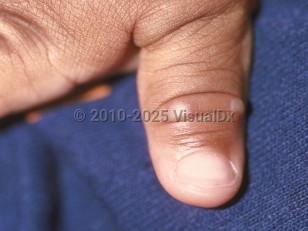Hand, foot, and mouth disease in Adult
See also in: Oral Mucosal LesionAlerts and Notices
Important News & Links
Synopsis

Hand, foot, and mouth disease (HFMD) is an acute, self-limited viral illness characterized by an oral enanthem with an accompanying macular, papular, or vesicular rash, notably on the hands, feet, buttocks, genitalia, and thighs. This typically lasts approximately 7-10 days. HFMD is predominantly caused by coxsackieviruses and other Enterovirus species.
HFMD is highly contagious and commonly transmitted in day care centers, schools, summer camps, and hospitals. Transmission of HFMD occurs via the fecal-oral route and through secretions, including secretions of vesicular fluid and nasal / oral fluid. Following infection, individuals can shed the virus via gastrointestinal passage for 4-6 weeks or via the upper respiratory tract for 3 weeks. Outbreaks usually occur from June to October. The incubation period for the virus is approximately 3-6 days.
HFMD primarily affects children, but adults can also develop the disease. Prodromal symptoms may include fever, abdominal pain, fussiness, emesis, and diarrhea. The typical course of infection starts with a mild fever, sore throat and mouth, cough, headache, malaise, diarrhea / vomiting, and occasional arthralgias. One to two days after the start of systemic symptoms, small oral macules can develop into vesicles and ultimately ulcerate. Lesions then develop on the hands, feet, and groin and can eventually become more widespread. Patients may have associated submandibular and cervical lymphadenopathy.
Coxsackievirus A6 (CV-A6) may cause atypical HFMD, where more extensive vesicle formation is seen, including on the forearms and in the perioral area. "Tomato flu" is an atypical presentation of HFMD that has been noted to occur in children in Kerala, India. Tense vesicles of differing sizes are seen on the extremities, including the palms and soles. Oral lesions may occur. Coxsackievirus A16 (CV-A16) has been isolated in 2 known cases.
HFMD from enterovirus A71 (EV-A71) can result in uncommon, severe sequelae, including encephalitis, interstitial pneumonia, flaccid paralysis, myocarditis, heart failure, meningoencephalitis, pancreatitis, conjunctival ulceration, and spontaneous abortion. Lesions are more likely to present on atypical sites such as the face, scalp, and ankles or diffusely on the whole body. Some patients may develop persistent myalgia / arthralgia. Complications are more severe in patients aged younger than 1 year or with EV-A71 infection.
Eczema coxsackium refers to the spread of a coxsackie viral exanthem in an underlying rash, most commonly atopic dermatitis. Widespread vesicles may be seen more frequently in this setting.
HFMD is highly contagious and commonly transmitted in day care centers, schools, summer camps, and hospitals. Transmission of HFMD occurs via the fecal-oral route and through secretions, including secretions of vesicular fluid and nasal / oral fluid. Following infection, individuals can shed the virus via gastrointestinal passage for 4-6 weeks or via the upper respiratory tract for 3 weeks. Outbreaks usually occur from June to October. The incubation period for the virus is approximately 3-6 days.
HFMD primarily affects children, but adults can also develop the disease. Prodromal symptoms may include fever, abdominal pain, fussiness, emesis, and diarrhea. The typical course of infection starts with a mild fever, sore throat and mouth, cough, headache, malaise, diarrhea / vomiting, and occasional arthralgias. One to two days after the start of systemic symptoms, small oral macules can develop into vesicles and ultimately ulcerate. Lesions then develop on the hands, feet, and groin and can eventually become more widespread. Patients may have associated submandibular and cervical lymphadenopathy.
Coxsackievirus A6 (CV-A6) may cause atypical HFMD, where more extensive vesicle formation is seen, including on the forearms and in the perioral area. "Tomato flu" is an atypical presentation of HFMD that has been noted to occur in children in Kerala, India. Tense vesicles of differing sizes are seen on the extremities, including the palms and soles. Oral lesions may occur. Coxsackievirus A16 (CV-A16) has been isolated in 2 known cases.
HFMD from enterovirus A71 (EV-A71) can result in uncommon, severe sequelae, including encephalitis, interstitial pneumonia, flaccid paralysis, myocarditis, heart failure, meningoencephalitis, pancreatitis, conjunctival ulceration, and spontaneous abortion. Lesions are more likely to present on atypical sites such as the face, scalp, and ankles or diffusely on the whole body. Some patients may develop persistent myalgia / arthralgia. Complications are more severe in patients aged younger than 1 year or with EV-A71 infection.
Eczema coxsackium refers to the spread of a coxsackie viral exanthem in an underlying rash, most commonly atopic dermatitis. Widespread vesicles may be seen more frequently in this setting.
Codes
ICD10CM:
B08.4 – Enteroviral vesicular stomatitis with exanthem
SNOMEDCT:
266108008 – Hand foot and mouth disease
B08.4 – Enteroviral vesicular stomatitis with exanthem
SNOMEDCT:
266108008 – Hand foot and mouth disease
Look For
Subscription Required
Diagnostic Pearls
Subscription Required
Differential Diagnosis & Pitfalls

To perform a comparison, select diagnoses from the classic differential
Subscription Required
Best Tests
Subscription Required
Management Pearls
Subscription Required
Therapy
Subscription Required
References
Subscription Required
Last Reviewed:04/30/2024
Last Updated:05/27/2024
Last Updated:05/27/2024
 Patient Information for Hand, foot, and mouth disease in Adult
Patient Information for Hand, foot, and mouth disease in Adult
Premium Feature
VisualDx Patient Handouts
Available in the Elite package
- Improve treatment compliance
- Reduce after-hours questions
- Increase patient engagement and satisfaction
- Written in clear, easy-to-understand language. No confusing jargon.
- Available in English and Spanish
- Print out or email directly to your patient
Upgrade Today

Hand, foot, and mouth disease in Adult
See also in: Oral Mucosal Lesion
